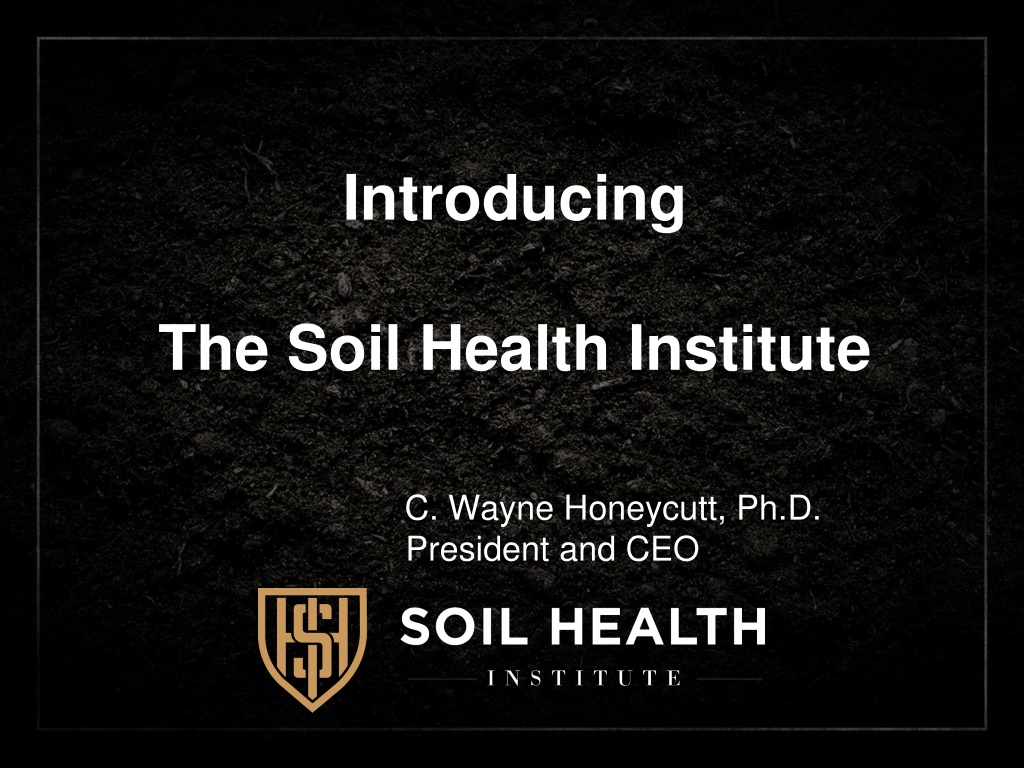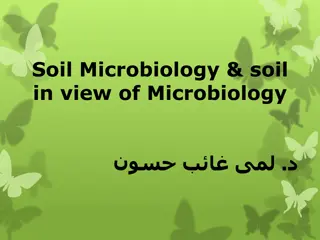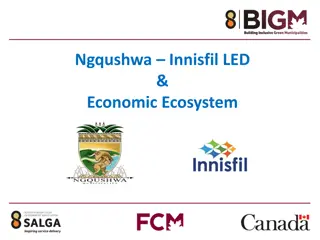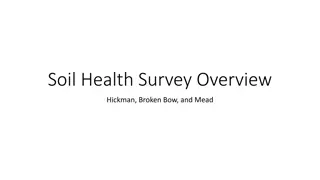Understanding Soil Health for Sustainable Ecosystems
Soil health, defined as the capacity of soil to function as a living ecosystem supporting plants, animals, and humans, is crucial for sustaining life. This content explores the imperatives, opportunities, and key practices such as no-till and cover crops to enhance soil health. It also delves into data on national rivers and streams assessment, illustrating the importance of maintaining soil health for environmental well-being. By implementing innovative strategies, we can improve soil organic carbon levels and water holding capacity, fostering a more resilient and sustainable environment.
Uploaded on Sep 25, 2024 | 0 Views
Download Presentation

Please find below an Image/Link to download the presentation.
The content on the website is provided AS IS for your information and personal use only. It may not be sold, licensed, or shared on other websites without obtaining consent from the author. Download presentation by click this link. If you encounter any issues during the download, it is possible that the publisher has removed the file from their server.
E N D
Presentation Transcript
Introducing The Soil Health Institute C. Wayne Honeycutt, Ph.D. President and CEO
SOIL HEALTH: The capacity of a soil to function as a vital, living ecosystem that sustains plants, animals, and humans.
National Rivers & Streams Assessment Biological condition: Poor - 55.3% Fair 23.3% Good 20.7% Unknown 0.8% Greatest stressors: Phosphorous Nitrogen Riparian cover and disturbance Streambed sediment Enterococci Source: USEPA (2016)
(10F) (7 F) Increasing Temperature (4 F) Adapted from Hayhoe 2011
35 SAND FC 30 Available Water Holding Capacity WATER (% by Volume) 25 20 15 10 PWP 5 0 0 ORGANIC CARBON (% by Weight) 2 4 6 8 Adapted from Hudson (1994)
Georgia studies Typic Kanhapludults. Franzluebbers (2010) SSSAJ 74:347 357
Soil Organic C (Mg/ha) State Years Conventional Tillage No Tillage IA 15 60.3 71.1 IL 6 45.4 51.3 IN 11 60.0 73.0 KY 5 45.9 52.8
USDA-SARE, CTIC Survey 2012 Corn Yield Drought States
Tillage & Cover Crop Impacts On Water Infiltration Rate Location Years Tillage & Crop Impact on Infiltration Rate Reference Blanco-Canqui et al. 15 NT Winter Wheat-Sorghum 182% Increase with Cover Crop KS (2011) Steele et al. (2012) 11 NT Corn 164-462% Increase with Cover Crop (different sites & years) MD Stone and Schlegel (2010) 11 NT Wheat- Sorghum-Fallow 132-194% Increase with No-Till KS TerAvest et al. (2015) 3 NT Corn 165% Increase in No-Till Malawi
Cover Crop Impacts on Nitrate Leaching Location Cover Crop Reduction in Nitrate Leaching (%) 65-70 30 63 61 Reference Wyland et al. (1996) Rye Rye CA DE Ritter et al. (1998) Martinez and Guirard (1990) Ryegrass Winter Wheat (and reduced fertilizer) Rye Rye Hairy Vetch Rye Rye Rye Rye France IN Kladivko et al. (2004) Kaspar et al. (2007) 61 94 48 77 80 IA KY KY MD MD MI MN McCracken et al. (1994) McCracken et al. (1994) Staver and Brinsfield (1990) Staver and Brinsfield (1998) Rasse et al. (2000) 28-68 13 Strock et al. (2004)
Initiated in 2013, Farm Foundation, NFP and the Noble Foundation initiated the Soil Renaissance to advance soil health and make soil health the cornerstone of land use management decisions. $ RESEARCH EDUCATION MEASUREMENT ECONOMICS Reawaken the public to the importance of soil health. Incorporate soil health measures into standardized soil testing that is readily available, affordable, and commercially viable. Quantify the effects of soil health on economic risks and returns. Convene the research community to advance soil health. 20
Mission Safeguard and enhance the vitality and productivity of the soil through science-based research and advancement
Guiding Principles Integrated Science Approach Science-based Partnership Driven Inclusive and representative Transparent and open sourced Communications at all levels Purposeful outcomes with measurable impacts Continuing evaluation and improvement Note: These guiding principles were developed by the Soil Renaissance strategic development committee and adopted by all working groups. 22
Governing Board Board Chair Soil Agricultural Producers (8-10) Professional Societies (2) Science and Technology (5) At Large (4) President/CEO Renaissance (2) Noble Foundation SWCS CLA Policy Farm Foundation Independent Labs Soil Science OFRF ASTA NACD Business/ Finance TFI 19-21 voting members 1 non-voting, ex officio (President/CEO) No compensation Rodale 23
Operational Structure Location: RTP Additional paid staff dependent on funding President/CEO Admin Chief Scientific Officer Measure- ments & Standards Chief Operating Officer Communica- tions & Educ. Research Economics Policy Development Experts
Research Identify gaps in soil health research Priorities/solicitations determined by CSO (in consultation with the CEO) with External Science Advisors. Construct research road maps Current research is not consolidated nor in useful user form. Soil health roadmap is a jigsaw puzzle of many pieces. Rigorous protocol related to submission of proposals and assessment of outcomes Research opportunities defined by continued Soil Renaissance convening hosted by the Soil Health Institute.
Soil Health Research Awards Open Solicitations Research and Educational Communities Award Recipients Awards and Funding Progress Reports and Data Proposal Submission Research Opportunity Announcements Direct Solicitations Awards and Funding Progress Reports and Scientific Review Panel(s) External Science Advisors Individuals from world-renowned organizations. Provide guidance and comment on progress and effectiveness of scientific programs. Data
Soil Health Institute Approach 1. Increase Adoption of SH Mgmt. Systems - Quantify impacts on profitability and economic risk. - Quantify SOC vs. AWHC relationships across soils, climates, cropping systems. Develop Decision Support System for producers. - Partner with boots on the ground organizations (NACD, LGU, NRCS, Agri- business, SH Partnership, ) for workshops, demonstration sites, field days, webinars,
Soil Health Institute Approach 2. Target Adoption of SH Mgmt. Systems - Determine potential water quality improvements for given levels of SH mgmt. system adoption (modeling). - Ground-truth model predictions with Edge-of- Field monitoring (Discovery Farms, LTARs, ) - From above, identify priority sub-watersheds
Soil Health Institute Approach 3. Quantify Adoption and Impact - Assess current status of soil health in U.S. - Assess current status of soil health practice adoption in U.S. - Use above for establishing baseline for measuring future progress























